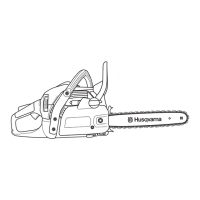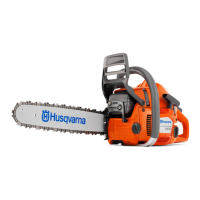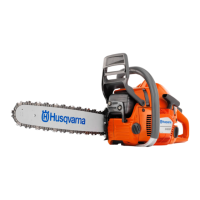Do you have a question about the Husqvarna 440 e-series and is the answer not in the manual?
Identifies and describes the main parts of the chain saw, providing a visual overview.
Details essential checks and procedures to follow before operating a new chain saw for the first time.
Lists and describes the mandatory personal protective equipment (PPE) required for safe chainsaw operation.
Details the operation, function, and maintenance of the chain brake and front hand guard system.
Explains the function of the throttle lockout in preventing accidental throttle engagement and ensuring safe idle.
Describes the system designed to reduce vibration transfer to the operator, enhancing comfort and usability.
Guidance on choosing and maintaining cutting equipment (bars, chains) for optimal performance and safety.
Instructions for proper chain sharpening and depth gauge adjustment to minimize kickback and ensure efficiency.
Details the procedure for adjusting the depth gauge, crucial for cutting performance and kickback reduction.
Step-by-step guide on how to properly tension the saw chain for safe and effective operation.
Explains the importance of proper chain and bar lubrication to prevent damage and ensure smooth operation.
Guidelines for inspecting the chain and bar for wear, and determining when replacement is necessary.
Provides detailed, illustrated instructions for correctly installing the bar and chain onto the chainsaw.
Information on the correct type, octane rating, and mixing ratio of gasoline for the chainsaw's two-stroke engine.
Guidance on selecting and using the appropriate two-stroke oil, emphasizing compatibility and performance.
Safety precautions and detailed procedures for refuelling the chainsaw, minimizing fire risk.
Guidelines for safely transporting and storing the chainsaw and its fuel, including long-term storage.
Outlines the fundamental steps and safety requirements for starting the chainsaw engine.
Specific procedures for starting a cold engine, including choke and air purge usage.
Specific procedures for starting a warm engine, detailing adjustments to choke and throttle settings.
Instructions on how to safely stop the chainsaw engine using the stop switch.
A checklist of pre-operation inspections to ensure the chainsaw is safe and in good working order.
Basic safety rules, operational tips, and important considerations for effective chain saw use.
Explains fundamental techniques for cutting wood safely, including body positioning and grip.
Techniques specific to safely removing branches from a felled tree, emphasizing caution.
General advice on cutting logs, including how to avoid kickback and maintain control.
Comprehensive guide to felling trees safely, covering directional cuts, safety zones, and retreat paths.
Factors affecting tree fall direction and methods to control it for safer felling operations.
Crucial safety information on understanding kickback causes and implementing techniques to prevent it.
Defines kickback and explains the specific conditions and parts of the guide bar involved.
Outlines user-level maintenance tasks and when professional servicing is required.
Details on adjusting the carburetor for optimal engine performance and reduced emissions.
Procedures for inspecting and servicing critical safety components like the chain brake and guards.
Checks to ensure the throttle lockout functions correctly and returns to idle position.
Guidance on checking the muffler's attachment, cleaning the spark arrestor screen, and its function.
Step-by-step instructions for replacing the starter cord, with safety warnings.
How to clean, maintain, and replace the air filter to prevent engine malfunctions and ensure performance.
Information on checking and replacing the spark plug to resolve starting and running issues.
Procedure for lubricating the bar tip sprocket, essential for chain lubrication and smooth operation.
Special measures and considerations for operating the chainsaw in cold weather conditions.
A comprehensive schedule detailing daily, weekly, and monthly maintenance tasks for the chainsaw.
Provides general specifications for the chainsaw models, covering motor, weight, and bar/chain details.
Detailed technical specifications of the engine, including displacement, bore, stroke, and power output.
Specifications related to the guide bar length, pitch, and chain dimensions for compatibility.
Lists recommended bar and chain combinations that meet safety standards for kickback and vibration.
Visual guide and specifications for saw chain filing angles and the use of file gauges.
Details the warranty rights and responsibilities for the 440e TrioBrake model related to emissions control.
Outlines the owner's obligations regarding maintenance and proper use to ensure warranty validity.
Lists the specific emission-related parts and systems covered under the manufacturer's warranty.
Details the warranty rights and responsibilities for the 445e TrioBrake model concerning emissions control.
Outlines the owner's responsibilities for performing required maintenance to maintain warranty coverage.
Lists failures caused by abuse, neglect, or improper maintenance that are excluded from warranty coverage.
General safety guidelines for chain saw users, focusing on safe operation and hazard avoidance.
Critical information on understanding, preventing, and reacting to dangerous kickback incidents.
| Cylinder Displacement | 40.9 cm³ |
|---|---|
| Weight | 4.4 kg |
| Engine Displacement | 40.9 cm³ |
| Weight (excl. cutting equipment) | 4.4 kg |
| Sound Power Level | 114 dB(A) |
| Oil Tank Volume | 0.25 l |
| Chain Pitch | 0.325 inches |
| Chain Pitch (alternative) | 0.325 inches |
| Chain Gauge | 0.05 in |
| Bar Length | 18 inches |
| Fuel Tank Volume | 0.37 liters |











